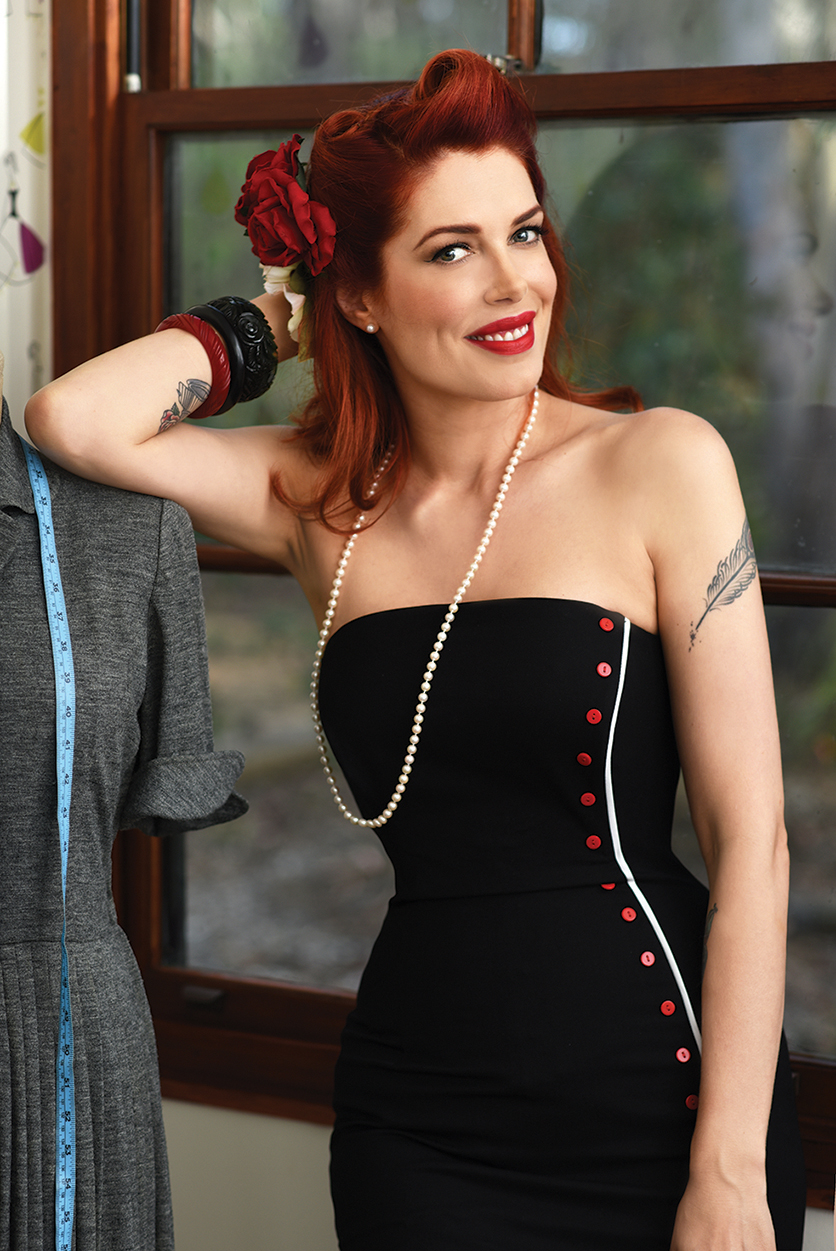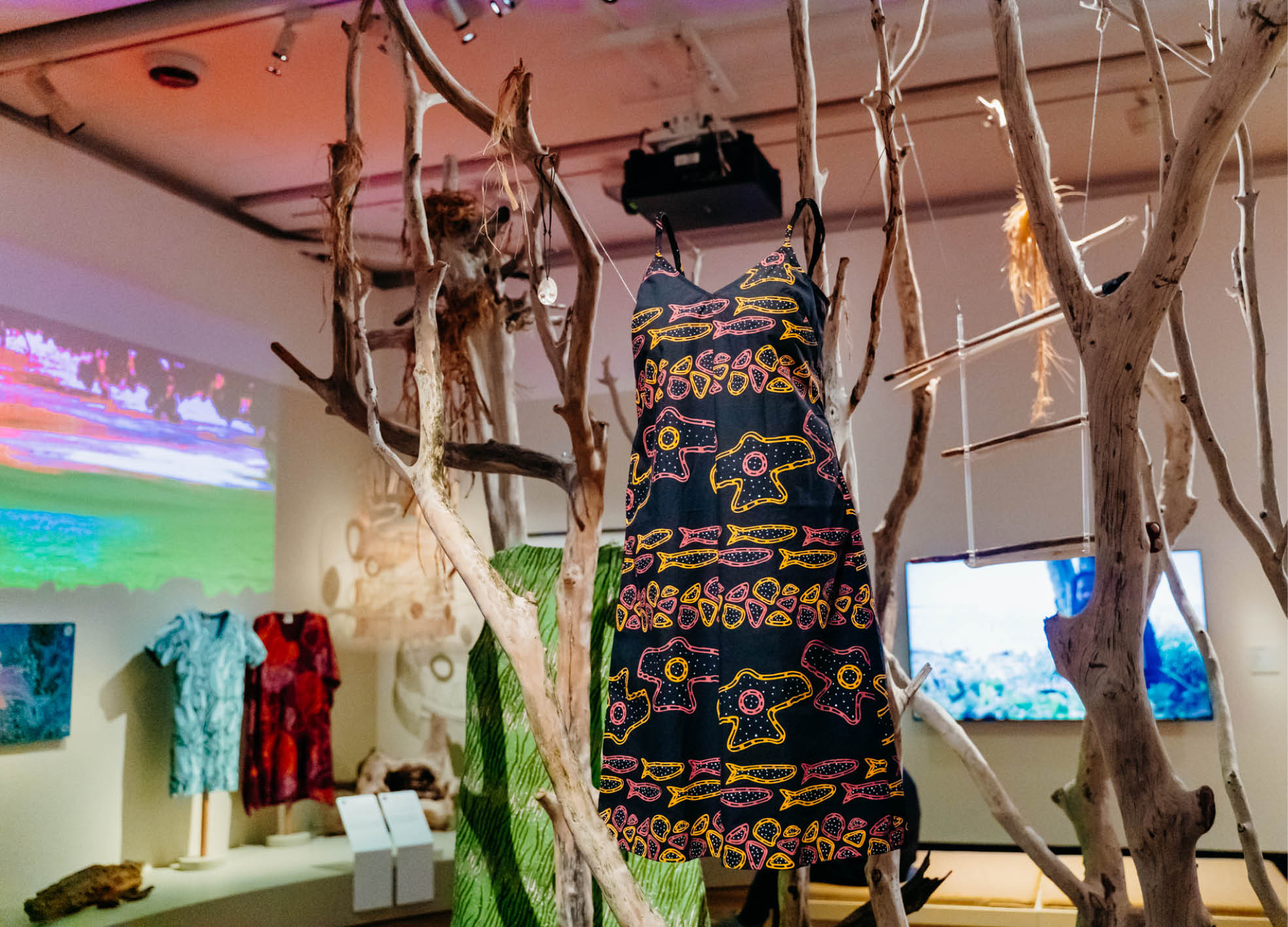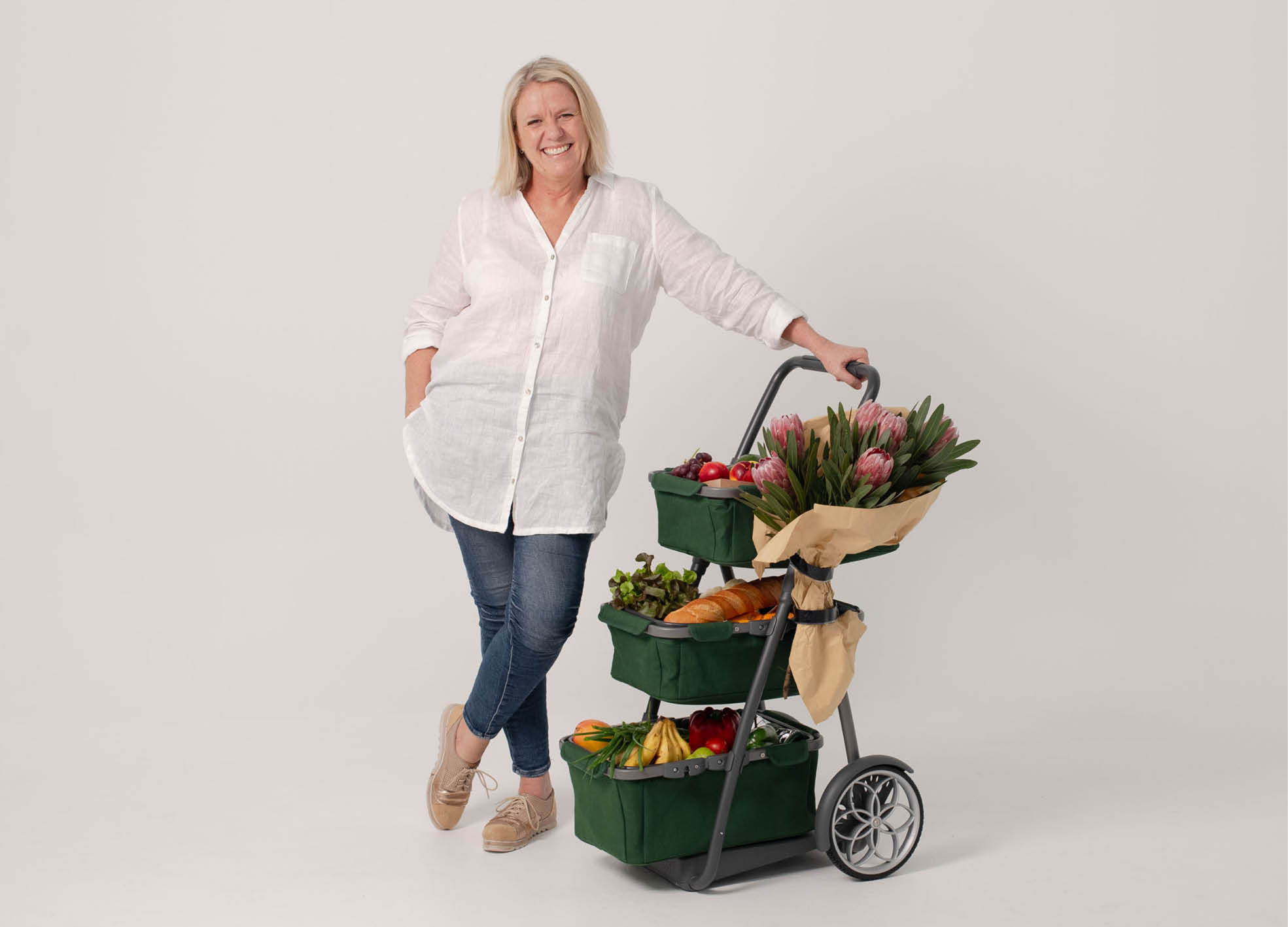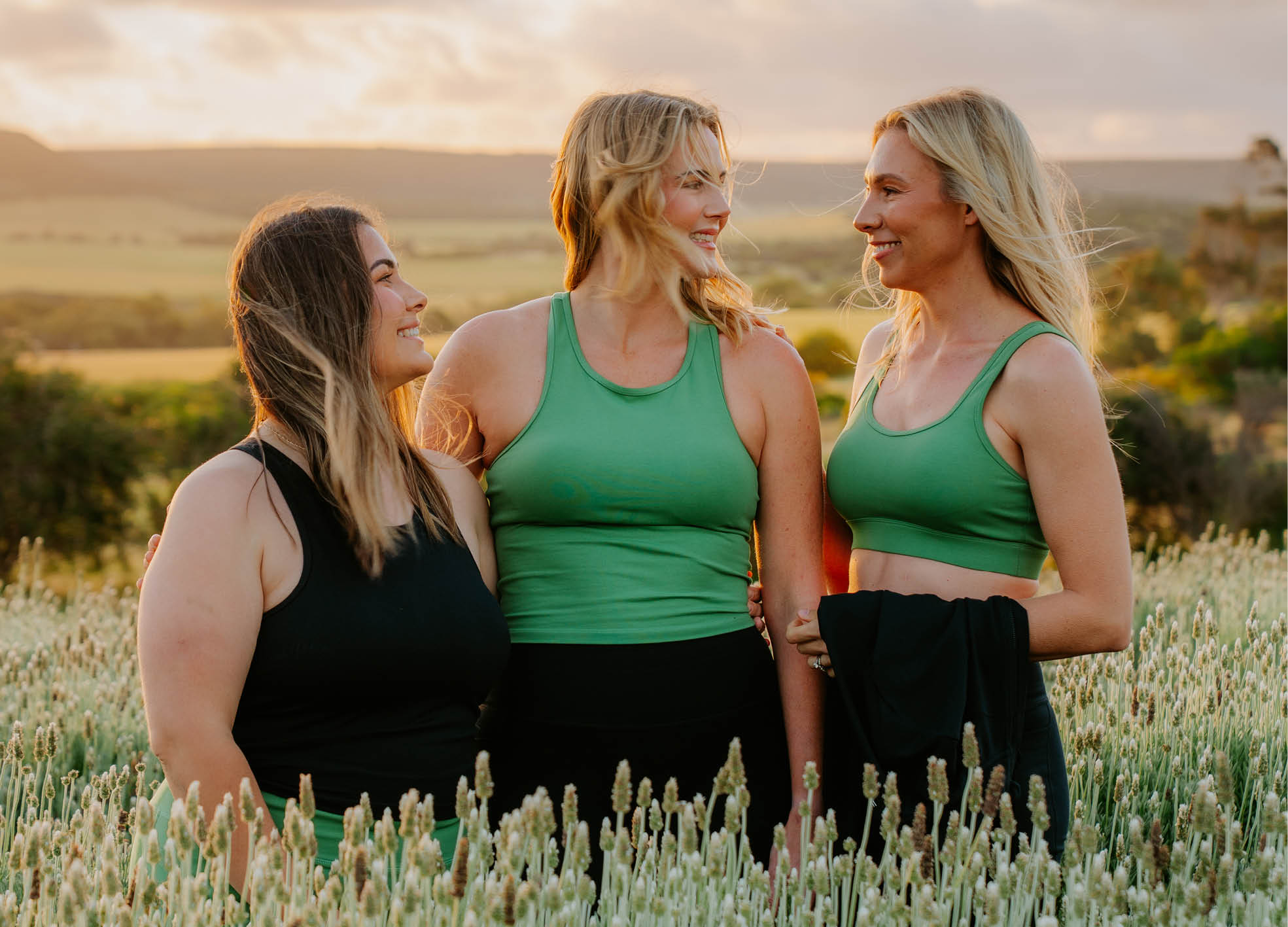Sewing Vintage with Tara Moss

- Words by Peppermint
Best-known as an author, advocate and all-round action woman, Tara Moss can now add vintage blogger and host of a Youtube channel – Sewing Vintage with Tara Moss – to her resume. We caught up with Tara to ask her about her passion for sewing, the exploration of typically gendered roles and why she feels it’s crucial to rediscover traditional skills.
What led you to take up sewing?
Just over a year ago I made a pact with myself to learn to sew. It was a vital life skill I lacked, and I had come to realise – a little overdue – how much I needed to learn. Clothing rarely fits me without personalised tailoring, as I don’t have a ‘standard’ body shape (who does?) and I always had to farm out the tailoring and mending, and in some cases I just wore things that didn’t fit as well as they should and eventually ended up collecting dust at the back of the closet. I decided enough was enough. It was time to learn how to make and mend my own clothes and to become self-sufficient and less wasteful.
As a complete beginner, what did you find most challenging?
It took me a while to understand patterns and garment construction. I still have much to learn, but even reading basic patterns was like learning a different language at first. I have a solid sense of clothing and design after decades of being around the fashion industry, but now I have a much better sense of how different garments and effects are achieved and what goes into the construction and sewing.
You’ve mentioned it may surprise those familiar with your ‘action woman’ persona to learn that you’ve taken up sewing. Why do you feel it’s important that we embrace both traditionally male and female pursuits?
Whether we identify as male, female or neither, we are all whole human beings, and I believe we benefit from exploring all aspects of ourselves and the world we live in. We can be leaders, and also caring. Progressive and also crafty. People of action and also quiet moments. There are many ways to be a human being, and a lot of traditional skills – those traditionally allotted to men or women – are absolutely vital to life and to our survival.
On your Youtube channel, you point out that cheap plastic sewing machines are almost impossible to repair. Does a ‘buy less, buy better’ mentality extend into other areas of your life? In what way?
Buy less, buy better should absolutely be a motto and philosophy carried through to all aspects of our lives. I want to buy things that can be repaired. I want to learn those skills.

Learning to mend, rather than throwaway, neatly complements the sustainability of buying vintage fashion. Why was it important to you to become more self-sufficient?
I have always been a big believer in self-sufficiency, and as a woman I have been incredibly self-sufficient except in regards to sewing, mending and some domestic skills. It’s hard to wear and love vintage without being about the mend and repair, so that really highlighted the skills I lacked, but those skills are important across the board, no matter what kind of clothes you wear or how you live your life.
How did learning to sew affect the way you look at clothing?
I have a lot more to learn, but I can now identify different construction techniques, stitches and fabrics, and that makes identifying quality much easier. I now look on the inside of clothes, and pay much more attention.
Has it influenced your buying decisions?
Absolutely. Once you have a real sense of garment quality and what goes into the process, and you really pay attention to the lovingly hand stitched hem or finish, you’ll never look at most factory-made modern clothing the same way again.
What have been the most rewarding moments of your sewing journey? Do any particular learnings or mistakes spring to mind?
Learning how to hand stitch a hem, which we show in Episode 9 of Sewing Vintage with Tara Moss, has been one of my favourite moments. Last year I completed a lovely custom pencil skirt from a pattern I amended, and I basically ruined it when I machine stitched the hem at the end. Well, it didn’t ruin it, but I could see right away that it brought the whole garment down, but I just didn’t know how to hem properly. I didn’t know any other way, because I was such a novice. After that, hemming my first dress with a beautiful, almost invisible hand stitched hem felt great.
What response have you had to your sewing school?
The sewing community has been so welcoming and encouraging, and I really appreciate it. Those who are newbies like myself have told me it has really helped them too, so I hope there is something for everyone, whether they are learning the basics, picking up couture hand sewing techniques or just want a little added encouragement to get back to sewing. It’s been a lovely journey so far.
What’s next for Sewing Vintage?
I am working on some sewing diaries at the moment – making 1940s land Army overalls, and a boned mid-century bodice – and I will be interviewing more wonderful experts in the coming months as well. I’m particularly thrilled to be visiting costume designer Marion Boyce at her Melbourne studio to ask her about her designs for Miss Fisher’s Murder Mysteries, The Dressmaker and more. I hope your readers will consider subscribing and following the journey so we can continue to bring these crafts and skills to a wider audience. I have great respect for the seamstresses, tailors, costumers and sewists out there, and I want their skills to be known and remembered.
Tara Moss is the host and producer of Sewing Vintage with Tara Moss, a vintage blogger at VictoryLamour.com and is the Patron of the Australian Sewing Guild.
–––––––––––––
PHOTOS: BERNDT SELLHEIM
JOIN OUR MAILING LIST
Brighten up your inbox with our not-too-frequent emails featuring Peppermint-related news, events, competitions and more!
explore
More articles
Furred, feathered, fishy, scaled… The pets we choose are as diverse as our personalities. (And apparently, quite often we resemble each other.) But they all deserve to be cared for in ways guaranteed to keep them safe, healthy, and happy.…
When you hang a painting on a wall, the story stays put. But when you wear a beautifully made garment that may as well be…
We all do it: fire up the car for a 5-minute drive to pick up groceries, drop off sewing supplies, or run a quick errand…
Here’s a question: who decided that natural fibres aren’t a great fit in activewear? For Geraldton mum-of-four Jade Payne, that question became paramount after a…
It’s beginning to look a lot like Christmas! And around here, that means mindful spending and meaningful gifts that last. Sure, this approach requires a…
When the algorithm gods reward dance trends over hand-thrown ceramics, and building a website feels more stressful than a tax return, where’s a maker to…
Hang out with us on Instagram
IT’S HERE! 🎉
Our fabulous new website is now live. To say we’re excited about this is an understatement.
Last year we were extremely excited to receive funding from the Meta Australian News Fund, in partnership with the Walkley Foundation. The result is this incredible new website from the amazing Amy and Jenny at @CrumpetClubHouse - massive round of applause! 👏🏼👏🏼👏🏼
Early next year we’ve got a sustainable fashion and sewing directory coming after YEARS of wanting to make it happen - we’re still working hard behind-the-scenes on that.
Go have a play on our new website and let us know what you think! And while you’re there, snap up a subscription or a sewing pattern… perfect for the gifting season!
www.peppermintmag.com
#PeppermintMagazine #CrumpetClub #NewWebsite #WhoDis #ChristmasGifts #SupportSmallBusiness

“Crafting is something that has come naturally since I was small and I just haven’t stopped. When I was smaller, I was interested in the end result. As I’ve gotten older, I realise it’s the process that keeps me coming back to craft. It’s a meditative state for me and I find the repetitive action of the stitching and felting quite therapeutic.”
Craving a world filled with warmth and whimsy? It’s all in a day’s work for textile artist @Cat_Rabbit, whose latest book, ‘Trinkets’, is bursting with felty food friends to make and cherish. Cat invited us into her universe, filled with cheeky characters, layered storytelling and loads of humour.
Plus: try the super sweet pattern for Cat’s Lucky Pickle, perfect to make as a stocking stuffer, extracted from Trinkets.
Read more from our ‘Just felt right’ feature in Issue 64, at newsagents and stockists now!
Photos: Tatanja Ross @On_JacksonStreet and Cat Rabbit
#PeppermintMagazine #CatRabbit #LuckyPickle #Craft #Crafting #Felting #FeltCrafts #Trinkets #ChristmasDecorations

Our hearts go out to everyone impacted by the Bondi Beach violence, especially the Jewish community. Also to the beachgoers, those who bravely helped and the first responders.
While it`s easy – and understandable – to get caught up in the horror of it all and direct anger at certain groups, remember this quote from teacher and author Erin Gruwell: "Don`t let the actions of a few determine the way you feel about an entire group."
“You don`t fight racism with racism. You fight racism with solidarity," said Bobby Seale of the Black Panthers. And solidarity is exactly what we need right now.
If you are feeling overwhelmed, you are not alone. Remember there is much more kindness in the world than hate. ❤️🩹
@LifelineAustralia has created a Bondi Beach Incident: Wellbeing support guide, where you’ll find information about common reactions, reassurance that what you’re feeling is valid, and ideas for taking care of your wellbeing.
https://lifeline.org.au/bondi-incident
You can also call Lifeline on 13 11 14, text on 0477 13 11 14 or chat at lifeline.org.au/crisis-chat anytime, no matter how this has impacted you.
@BeyondBlueOfficial is also available with free 24/7 support by phone on 1300 22 4636 or webchat at https://www.beyondblue.org.au/
Register.Find.Reunite. has been activated by @RedCrossAu to help people reconnect with family and friends. Visit redcross.org.au to access the service.
@NSWPolice Public Information and Inquiry Centre (PIIC) is operating 24/7 on 1800 227 228 for information relating to people impacted.
@LifeBloodAu is supporting Sydney hospitals. O- and O+ blood are always in high demand in emergencies. To donate (from anywhere in Australia – all states are welcome and helpful!) call 13 14 95 or use the Lifeblood app.

Just a reminder… from @SugarHouseCeramicCo
This holiday season be kind, patient and shop local!
#ShopSmall #ShopLocal #SupportSmallBusiness

✨️ Our website is getting a glow-up! ✨️
Sorry for the inconvenience but it will be offline for a few days. You can still purchase subscriptions (perfect for chrissy presents!) via the links on the holding page.
Last year we were extremely excited to receive funding from the Meta Australian News Fund, in partnership with the Walkley Foundation. The result of this is a fabulous new website, with a sustainable fashion and sewing directory that will follow early next year. We`ve worked with the lovely Amy and Jenny at @CrumpetClubHouse who have been making the magic happen – we can`t wait to show you the outcome! ✨️
In the meantime, please get in touch if you need help with anything – hello@peppermintmag.com
We`ll see you on the other side! 🌈

🎀 12 DAYS OF XMAS GIVEAWAYS 🎀
🎄On the 12th day of Christmas, we’re giving away… a GREENPAN FROST ICE CREAM & FROZEN DRINK MAKER! 🎄
Ice, ice, baby! Calling all kitchen magicians and dessert devotees: it’s time to churn, blend and devour your way to frozen heaven. It’s our final giveaway – and hoo girl, it’s a goodie! Thanks to the clever folks at @TheOriginalGreenPan.Anz, one reader will cool their mitts on the Frost Ice Cream & Frozen Drink Maker – perfect for conjuring up home-made gelato, sorbet, smoothies, slushies and more!
Valued at $599, the Frost Ice Cream & Frozen Drink Maker is designed with GreenPan’s signature Thermolon™ ceramic non-stick coating, so you can whip up summer-ready sweet treats free of PFAS, PFOA, lead and cadmium.
To snag this frosty prize, follow @TheOriginalGreenPan.Anz and tag a friend in the comments below before midday AEST 15 December! (Australian and New Zealand addresses only, please.) Good luck!
Update: The lucky winner of our final giveaway is @just__for__van - congrats! We`ll dm to get your details. Well done! 🎉
#PeppermintMagazine #12DaysOfChristmas #12DaysOfGiveaways #GreenPan
















